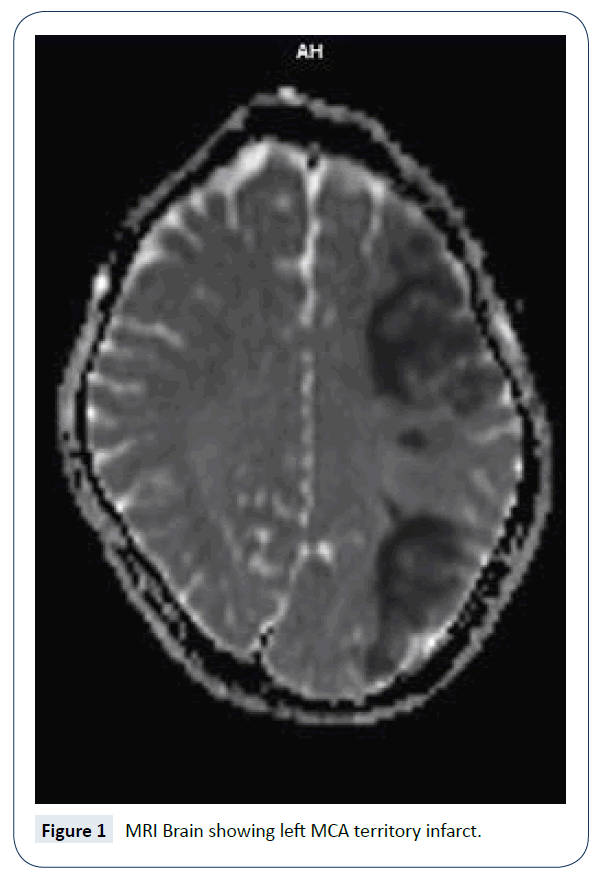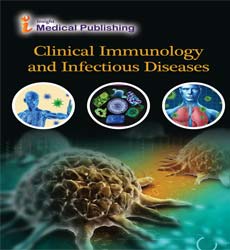Prashant Kumar Tripathi* and Jyoti Garg
Vivekananda Polyclinic and Institute of Medical Sciences, Lucknow, India
- *Corresponding Author:
- Prashant Kumar Tripathi
Vivekananda Polyclinic and Institute of Medical Sciences
Lucknow, Uttar Pradesh, India
E-mail: tripathiprashant49@gmail.com
Received Date: August 05, 2017; Accepted Date: September 19, 2017; Published Date: September 25, 2017
Citation: Tripathi PK, Garg J (2017) Case Report of Young Stroke with Pre Mature Atherosclerosis Attributed to Ankylosing Spondylitis. J Rare Disord Diagn Ther. 3:11. doi: 10.21767/2380-7245.100164
Keywords
Ankylosing spondylitis; Rheumatic condition; Cardiovascular risk factors; Young stroke
Introduction
Annually, 15 million people worldwide suffer a stroke. Of these, 5 million die and another 5 million are left permanently disabled, placing a burden on family and community. Stroke is uncommon in people under 40 years; when it does occur, the main cause is high blood pressure [1]. The age group for stroke in young has been variable between different studies but perhaps should be restricted to 15-49 years as this age group tends to have a unique set of causes and risk factors [2]. Ankylosing Spondylitis (AS), an autoimmune disease with systemic inflammation, predominantly involves the axial skeleton [3]. Two observational studies have reported an increased risk of cerebrovascular diseases in AS patients [4,5], whereas another study found that AS patients had no increased prevalence of stroke compared to non-AS patients [6].
Case Report
A 28 years old male presented to our emergency opd with sudden onset complete weakness of right half of body with loss of speech. There was history of vomiting 4-5 episodes just before the weakness, but not associated with seizures, loss of consciousness or headache. On examination right upper and lower limb were hypotonic with grade zero power. There was atrophy of bilateral lower limbs more so below the knees. Right side plantar response was extensor. On further examination right sided upper motor neuron type facial palsy was noticed. Initially on presentation the sensations were absent in right upper and lower limbs, which gradually recovered with recovery of some degree of power within a period of 3-4 days in an ascending fashion. At the end of four days, the power in right lower limb was grade 4 and in right upper limb was grade zero, with return of sensory functions to normal.
The patient was a known case of AS (HLA B27 positive), on treatment since 2 years- on methotrexate, folic acid, NSAIDs, calcium and vitamin D supplements. He had history of bilateral sacroilitis and left uveitis since 1 year, history of pain and swelling in bilateral knee joints since 1 year. Patient had no history of addictions or any significant positive family history.
His routine blood investigations were normal and an MRI brain (Figure 1) revealed multiple areas of altered signal intensity in the cortex and white matter in left lateral frontal, temporal and parietal lobes including left basal ganglia which showed restricted diffusion-suggestive of acute infarcts (left MCA territory). His carotid Doppler revealed a soft plaque in left carotid bulb extending to left internal carotid artery causing high resistance flow changes in left internal carotid artery. His 2D echo was unremarkable.
A diagnosis of young stroke was made and etiology of inflammatory atheromatous plaque due to AS was put forward. The patient was started on aspirin, clopidogrel and atorvastatin therapy and recovered in terms of improvement in power of right lower limb and speech within a week. Regular follow up with physiotherapy was advised on discharge.
Discussion
Inflammation plays an important role in the pathogenesis and progression of atherosclerosis [7-11]. Previous studies have shown that compared to patients without AS, AS patients have higher levels of inflammatory markers, such as interleukin-6, tumour necrosis factor alpha, and c reactive protein [9,12,13]. Thus AS patients have early features of atherosclerosis such as an increase in intima media thickness in the carotid arteries [14]. And an increased risk of ischemic strokes.
It was shown in a study conducted by Yao-Min Hung et al. [15] that there is an increased risk of developing ischemic stroke in young patients with AS. Study conducted by Inderjeet Verma et al. [16] demonstrated that patients with AS without traditional cardiovascular risk factors have an increased carotid intimamedia thickness compared to matched healthy controls. A population based longitudinal follow up study conducted by Lin CW et al. [17] showed that there is an increased risk of ischemic stroke in young with AS and highlights the importance of early risk assessment for ischemic stroke in such patients.
Conclusion
The present case report is rare cause of young stroke and prompts cardiovascular evaluation of patients with inflammatory diseases, AS being one of them. Previous studies emphasize the role of screening in such patients by means of carotid intima-media assessment so that future risk of cardiac or CNS complications can be addressed.
References
- Cardiovascular disease (2017) World Health Organization (WHO).
- Kameshwar Prasad, Kapil K. Singhal (2010) Stroke in young: An indian perspective. Neurology India 5: 343-350.
- Braun J, Seiper J (2007) Ankylosing Spondylitis. Lancet 369: 1379-1390.
- Han C, Robinson DW Jr, Hackett MV, Paramore LC, Freaeman KH, et al. (2006) Cardiovascular disease and risk factors in patients with rheumatoid arthritis, psoriatic arthritis, and ankylosing spondylitis. J Rheumatol 33: 2167-2172.
- Szabo SM, Levy AR, Rao SR, Kirbach SE, Lacaille D, et al. (2011) Increased risk of cardiovascular and cerebrovascular diseases in individuals with ankylosing spondylitis: A population based study. Arthritis Rheum 63: 3294-3304.
- Kang JH, Chen YH, Lin HC (2010). Comorbidity profiles among patients with ankylosing spondylitis: A nation wide population based study. Ann Rheum Dis: 1165-1168.
- Bremander A, Peterson IF, Bergman S, Englund M (2011) Population based estimates of common co morbidities and cardiovascular disease in ankylosing spondylitis. Arthritis Care Res 63: 550-556.
- Ross R (1999) Atherosclerosis- an inflammatory disease. N Engl J Med 340: 115-126.
- Pearson TA, Mensah GA, Alexander RW, Anderson JL, Cannon RO 3rd, et al. (2003) Markers of inflammation and cardiovascular disease: application to clinical and public health practice: A statement for healthcare proffessionals from the centers for disease control and prevention and the Americam Heart Association. Circulation 107: 499-511.
- Verma S, Anderson TJ (2002) Fundamentals of endothelial function for the clinical cardiologist. Circulation 105: 546-549.
- Stoll G, Bendszus M (2006) inflammation and atherosclerosis: novel insights into plaque formation and destabilization. Stroke 37: 1923-1932.
- Gratacos J, Collado A, Filella X, Sanmarti R, Canete J, et al. (1994) Serum cytokines(IL-6, TNF-alpha, IL-1 beta and IFN-gamma) in ankylosing spondylitis: A close correlation between IL-6 and disease activity and severity. Br J Rheumotol 33: 927-931.
- Lange U, Teichmann J, Stracke H (2000) correlation between plasma TNF- alpha, IGF-1, biochemical markers of bone metabolism, markers of inflammation/disease activity, and clinical manifestations in ankylosing spondylitis. Eur J Med Res 5: 507-511.
- Hamdi W, Chelli Bouaziz, Zouch I, Ghannouchi MM, Haouel M, et al. (2012) Assessment of preclinical atherosclerosis in patients with ankylosing spondylitis. J Rheumatol 39: 322-326.
- Yao-Min H, Wei-pin C, Cheng-Chung J, Pesus Chou, Yung-Pou WP (2016) Midlife Ankylosing Spondylitis Increases the Risk of Cardiovascular Diseases in Males 5 Years Later. Medicine 95: e 3596.
- Inderjeet Verma, Pawan Krishan, Ashit Syngle (2015) Predictors of Atherosclerosis in Ankylosing Spondylitis. Rheumatol Ther 2: 173-182.
- Lin CW, Huang YP, Chiu YH, Ho YT, Pan SL (2014) Increased risk of ischemic stroke in young patients with ankylosing spondylitis: A population based Longitudinal folloew-up stody, PLOS ONE 9: e94027.
Open Access Journals
- Aquaculture & Veterinary Science
- Chemistry & Chemical Sciences
- Clinical Sciences
- Engineering
- General Science
- Genetics & Molecular Biology
- Health Care & Nursing
- Immunology & Microbiology
- Materials Science
- Mathematics & Physics
- Medical Sciences
- Neurology & Psychiatry
- Oncology & Cancer Science
- Pharmaceutical Sciences

